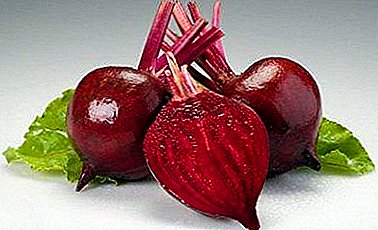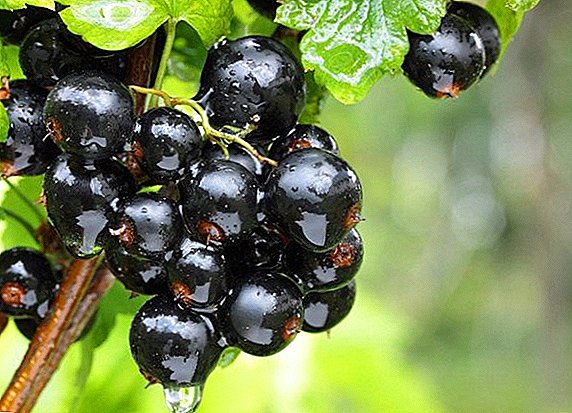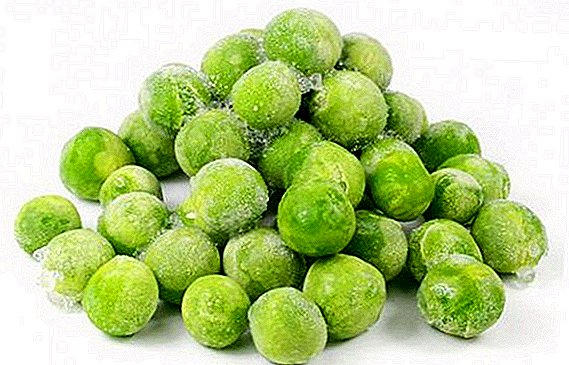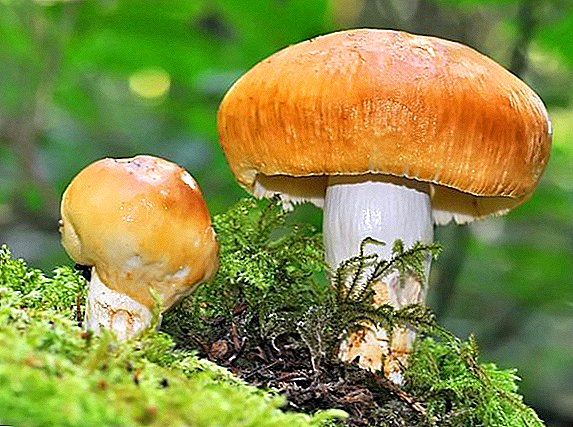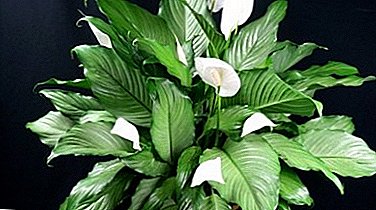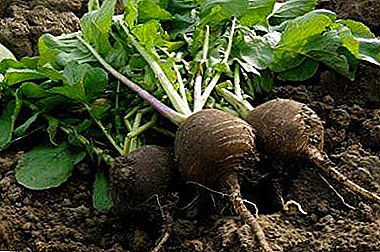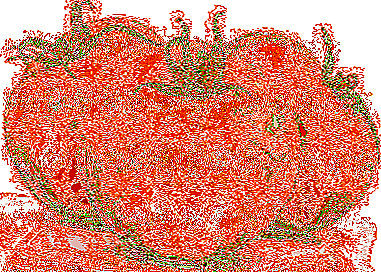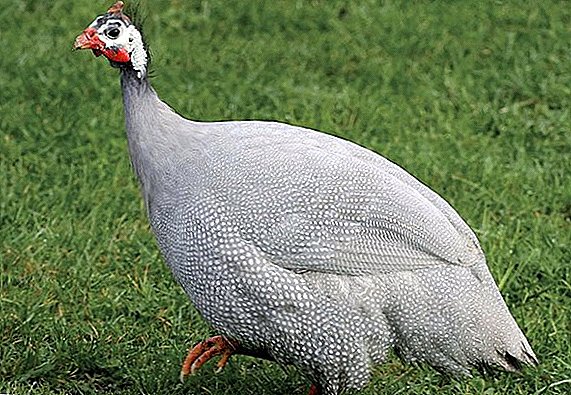 In the global poultry industry, breeding guinea fowls occupies one of the leading positions. The meat of these birds in their taste and useful qualities much higher than chicken. Today we will talk about the blue guinea fowl, its characteristics and conditions of detention.
In the global poultry industry, breeding guinea fowls occupies one of the leading positions. The meat of these birds in their taste and useful qualities much higher than chicken. Today we will talk about the blue guinea fowl, its characteristics and conditions of detention.
Appearance and physique
The name of the species was due to its unusual blue-blue color. Birds of small sizes with a small head, pink comb and the same color earrings. The beak repeats the color of the ridge, and a dark gray stripe is clearly visible above the dark eyes. The head is devoid of feathers, and between the beak and the crest there is a pale blue keratinized growth.
Check out the list of wild and domestic breeds of guinea fowls.
The cone-shaped neck smoothly passes into an elongated oval-shaped body. A dark gray, almost black stripe girdles the neck closer to the head, and the rest of the shade on the neck is gray-blue. On a sloping back, a convex chest and wings, the basic color is diluted by white specks. It is noteworthy that the shade is not even everywhere: the wings, the stomach and the short tail lowered down can have a plumage of lilac tone. Strong, widely placed paws of dark gray color.  Newly hatched chicks have a gray-brown plumage, after the first molt they acquire the characteristic shade of the breed.
Newly hatched chicks have a gray-brown plumage, after the first molt they acquire the characteristic shade of the breed.
Did you know? In the US, guinea fowl is popular with farmers not only because of its tasty meat, this bird helps to destroy insect pests and parasites, such as ixodid ticks, which are dangerous to humans because they carry encephalitis.
Other features
Consider the productivity of the royal bird:
- male weight - up to 2 kg, females - up to 2.5 kg (plucked carcass of dark color, whitens when cooked);
- egg production - up to 150 pieces, weighing up to 48 g each;
- pear-shaped bird eggs with a thick brownish shell, darker than chicken eggs;
- with the walking method, laying hens are productive from March to early autumn;
- fertility rate - 86%;
- young survival rate - 95%;
- puberty comes at eight months.
 Thanks to the thick shell, eggs are not only protected from the penetration of bacteria, but also tolerate transportation.
Thanks to the thick shell, eggs are not only protected from the penetration of bacteria, but also tolerate transportation.Read about the features of breeding and feeding of guinea fowls in winter.
Necessary conditions for the content
Guinea fowls are small birds in size, so there will be no difficulties with their placement, the main thing is to create the necessary moisture and heat regime for them, it is convenient to arrange the room inside.
Arrangement of the house
So, the room and its arrangement imply:
- litter - up to 15 cm tall of sawdust, peat or straw;
- temperature regime - + 14-18 ° C;
- humidity - 60%, the presence of a ventilation system, the absence of drafts;
- lighting - 16 hours a day;
- placement density - 1 square. m for two individuals;
- resting place - perches up to 50 cm in height from the floor;
- nests - are located in a darkened place;
- There should be a lot of watering because birds have a great need for water.
Important! Since females can be afraid of any noise and throw the clutch, it is better to hatch in the conditions of the incubator.

Clean and disinfect the room
The pledge of herd health is a clean and well-kept room, for which a number of measures are observed:
- The litter is changed as it is polluted in order to eliminate the multiplication of pathogenic bacteria.
- To eliminate moisture on the litter, you can use nipple drinkers, from which it is difficult to splash water.
- Regularly need to clean the entire room, wash the feeder with disinfectant.
- Experienced poultry farmers advise sprinkling the floor with slaked lime before laying the house.
- Be sure to provide an airing system, fresh air is vital, especially in cold weather in the absence of walking.
- Once every two months, general cleaning is carried out followed by disinfection of the entire premises and equipment.
- Birds should be regularly inspected to prevent mass infection by any ailment.
Walking yard
Youngsters are accustomed to free movement at the site gradually, first they are released into the enclosed enclosure. If it is assumed constant walking of the closed type, then the area of the walking area should be about 13 square meters. m
In order for the guinea fowl not to fly away from the yard, we advise you to find out how to properly trim its wings.
In this case, shrubs should be planted on the territory, providing a shelter for rest from the heat. Be sure to install a drinker on a walk: birds can get a heat stroke without having access to water.  Guinea fowls with pleasure walk around the garden, destroying pests and not touching the crops. But outdoor walking is good only when the site is far from any sources of noise: the road, the playground. In addition, the birds need to trim the wings - they are quite capable of jumping over a low fence.
Guinea fowls with pleasure walk around the garden, destroying pests and not touching the crops. But outdoor walking is good only when the site is far from any sources of noise: the road, the playground. In addition, the birds need to trim the wings - they are quite capable of jumping over a low fence.
What to feed
The diet of the royal birds is rather simple:
- in the first week of life - boiled eggs, cereal, cottage cheese with greens;
- second week - mash bags with crushed grain, greens, dry food in small quantities;
- on the third week, the youngsters are released for walking, where he himself produces insects and worms.
It is useful to learn how to care for guinea fowl chickens.
Babies are fed in small portions 6-8 times a day, adults 3 times. It should be remembered that fresh water should always be available for these birds.  Food for adults:
Food for adults:
- greens - nettle, clover, lettuce, dandelion;
- vegetables - pumpkin, cabbage, potatoes, carrots, zucchini;
- grain - maize, wheat, barley, oats, millet, germinated cereals;
- wet food - cottage cheese, yogurt, fish offal;
- additives - needles, shell rock, chalk, fish oil, yeast, salt, meat and bone and fish meal.
Did you know? According to an ancient Greek legend, the gods turned the sisters of the hero Meleagr into kosarok, because they dared to ask for mercy for him. The gods punished the hero for the murder of his uncle, brother of his mother, committed during the military feuds. By the way, the scientist Carl Linnaeus gave the mind a double name - Numida meleagris, paying tribute to the legend and heroic deeds.To summarize: breeding guinea fowls can be quite a profitable occupation, since both meat and egg products are highly valued. In order for the livestock to develop normally and enjoy high productivity, it is necessary to provide it with a healthy and comfortable content.


